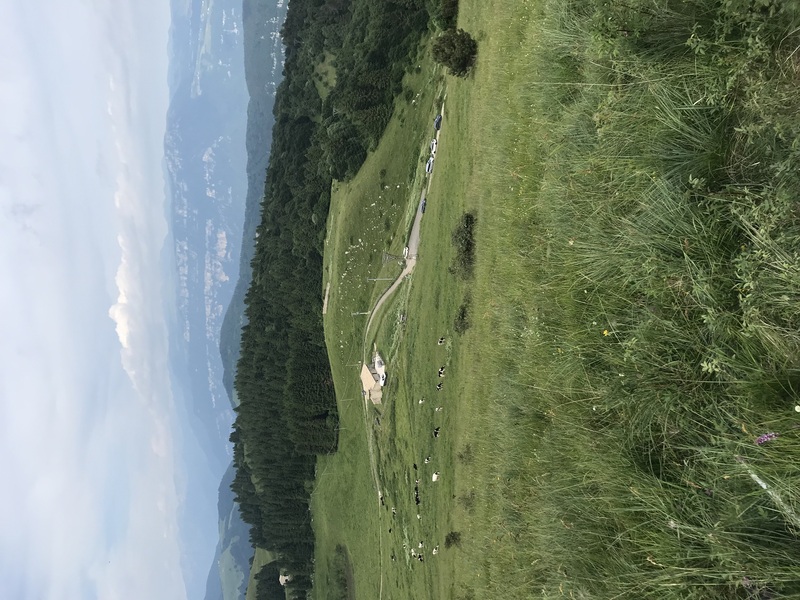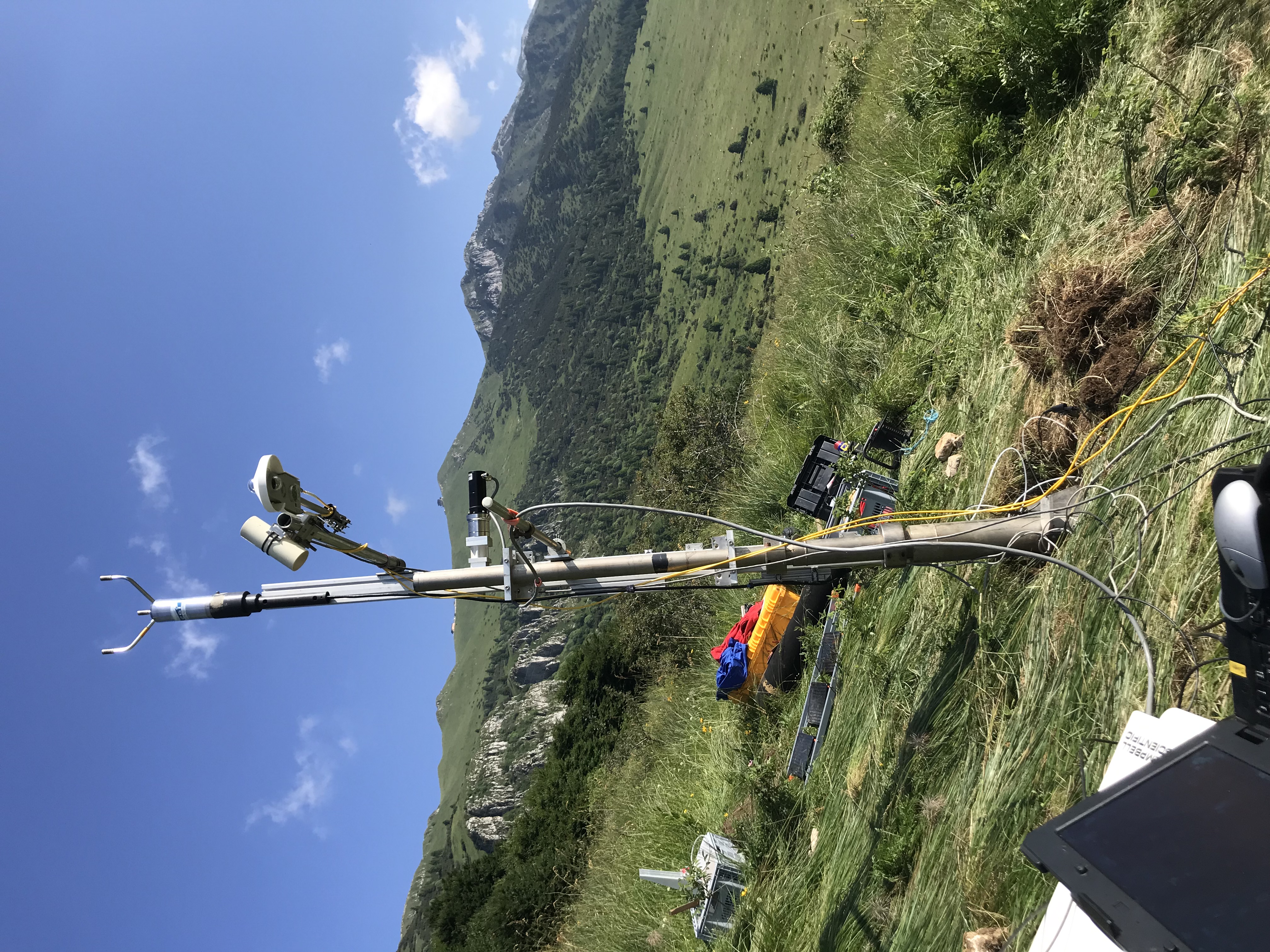
The project involves taking part in an observation campaign in the Italian Alps near Trento (Adige Valley), as part of the European alpine project TEAMx in 2025-2026, focusing on mountain meteorology and its links with climate change. We are focusing in particular on thermal winds, gravity flows generated by radiative effect at the surface, generally observed during anticyclonic conditions. There are few in situ observations of anabatic processes along steep alpine slopes, nor of their contribution to the triggering of deep convection. The aim of this project is to observe and better understand wind-generated turbulence near the surface. It is also a necessary step towards the development of sub-mesh convection parameterization including topography dependence, a missing piece in current global and regional climate models.
The present project is part of the international TEAMx project to observe mountain meteorology in the European Alps, with a focus on exchange processes in the atmosphere in complex relief https://www.teamx-programme.org .
The focus here is on just one aspect of the atmospheric boundary layer, that of diurnal slope winds (anabatic winds) and their contribution to deep convection processes in alpine relief.
The problem is multi-scale, from turbulence in the surface boundary layer to the triggering of vertical convection, and involves the transport and exchange of air mass, momentum and heat.
There are few observations of these processes in mountainous terrain, particularly in a collaborative integrative framework such as that proposed by the TEAMx observation campaign in summer 2025.
Moreover, meteorological models are particularly sensitive to surface conditions, so a better understanding of the processes involved is needed to improve parameterization, especially in mountainous terrain.
Finally, the impact of these processes, which initiate larger-scale phenomena such as deep convection, is crucial and needs to be better described to improve climate models and ultimately predict climate disruption mechanisms more accurately.
There are few detailed observations of the mechanisms involved in the formation of anabatic winds on alpine slopes, or of their physical modeling.
A synthesis of the open questions on the subject is given by Dino Zardi's team (univ. Trento, Italy) in a recent publication: Farina, S., Zardi, D. Understanding Thermally Driven Slope Winds: Recent Advances and Open Questions. Boundary-Layer Meteorol 189, 5-52 (2023). https://doi.org/10.1007/s10546-023-00821-1
The present project is innovative in that it proposes to deploy a series of turbulence measurements in the vicinity of a steep slope in the context of the international TEAMx project in the Adige Valley (Italy).
This is an important topic for improving the modelling of surface turbulent flows in complex terrain, and for reviewing the wall laws adapted accordingly.
Beyond the surface boundary layer, the study should provide a better understanding of atmospheric boundary layer phenomena in the mountains, and improve their representation in global or regional atmospheric models, whether for meteorological or climatological applications.

A classical approach to coupling is given by Prandtl's (1942) model, which also includes turbulent effects, but little is known about the very close flow region below the maximum jet velocity for steep-slope configurations. Preliminary results obtained as part of a LEFE IMAGO 2021 (COCA) project, during a recent campaign of in situ measurements carried out during the winter of 2023 in the French Alps near Grenoble, have enabled us to accurately assess the properties of the turbulent boundary layer in the region below the katabatic jet maximum, in relation to the effects of gravity. Another campaign was made as part of the European alpine project TEAMx in 2024-2026 in the Austrian Alps near Innsbruck (COCAINN project). The aim is to provide a continuous set of measurements from the ground up to a height of 1m, i.e. close to the maximum jet height, using a multi-hole 3D velocity probe (Cobra Pitot STI sensor) involving differential pressure measurements at high sampling frequency (1250 Hz), mounted on a high-precision vertical displacement system (0.1 mm accuracy). Measurements will be taken from z = 2 mm close to the snow surface (z+ = 20 expressed in wall units) to z = 1 m high (z+ = 10000). Measurements of the 3 velocity components will be collected during katabatic episodes lasting around 30 minutes, and will consist of a vertical profile of around 20 3D velocity samples, each lasting 1 minute.
The research question addressed is twofold: on the one hand, to deepen general knowledge of the turbulent properties of slope winds (and more particularly anabatic winds) in the zone very close to the surface, rarely observed in situ for technical and logistical reasons (millimetric scales not easily accessible with conventional meteorological probes), by adapting in situ 3D velocity measurement probes with high frequency resolution and reduced size (generally used in laboratory wind tunnels), to propose and validate a set of wall laws needed to consistently define surface boundary conditions for the appropriate use of regional models in the mountains and on complex reliefs in general (e.g. Meso-NH, SURFEX, at Météo France). Results obtained as part of an INSU/LEFE project, during a recent campaign of in situ measurements carried out during the winter of 2023 in the French Alps near Grenoble, have enabled us to accurately assess the properties of the turbulent boundary layer in the region below the jet maximum for a nocturnal catabatic configuration, in relation to gravity effects (paper presented at Euromech Colloquium 608 ‘Dynamics of gravity currents’ in June 2023 and the Meteorology Society Annual Meeting 2024, Barcelona, Spain, 1-6 Sep 2024). Preliminary trends have also been published (Charrondière et al., JFM 2022) based on measurements taken with the same probe as part of the 2019 campaign on the slopes of Grand Colon, Belledonne massif (data available on a Zenodo repository https://doi.org/10.5281/zenodo.6546702 ). The overall aim of the study is to transpose these katabatic wind studies to an anabatic updraft configuration during a full observation campaign planned as part of the TeamX European alpine project in 2024-2026 in the Italian Alps (ADIGE valley) near Trento. In addition, the observation of anabatic winds will highlight the key processes to be taken into account in the conceptualization of sub-mesh parameterizations for large-scale models. In particular, the observations made will enable us to assess the diurnal cycle of thermals, their characteristics as a function of slope geomorphology, their interactions with mesoscale circulation, and help highlight the key parameters of numerical schemes currently being designed (PhD by Nathan Philippot, IGE-Météo France, 2023-2026).